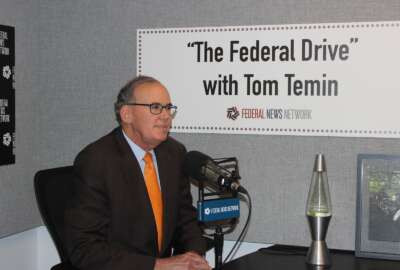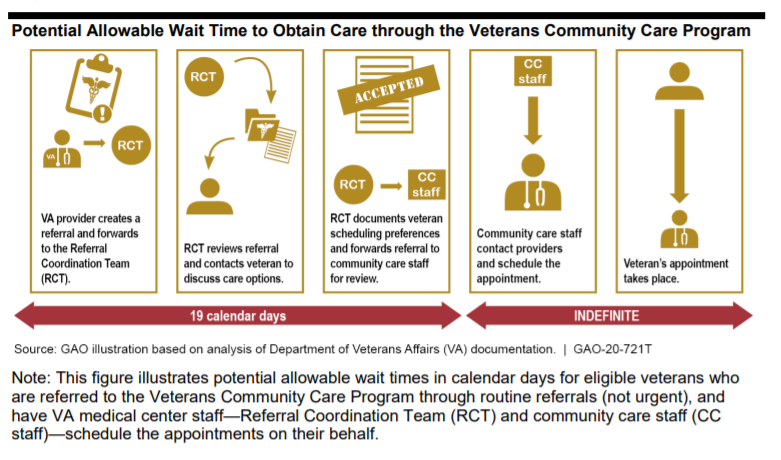

The Department of Veterans Affairs said standard community care wait times, similar to the metrics it has for its own health services, aren't necessary, especia...
The Department of Veterans Affairs lacks clear standards for how long veterans can expect to wait for an appointment with a community care provider.
For some members of Congress, a lack of clear wait time metrics calls into question the point of VA’s community care program, as veterans can’t easily compare how long they’ll expect to wait for health services at the department versus the private sector.
According to VA internal data from October 2019 through June 2020, veterans waited an average of 41.9 days for an appointment in the community, starting from the time he or she requested the appointment to the time the meeting occurred, Julia Brownley (D-Calf.), chairman of the House Veterans Affairs Health Subcommittee, said during a hearing Wednesday.
The Government Accountability Office found VA’s own bureaucratic referral and scheduling process eats up roughly half of that time.
Under the MISSION Act, which Congress passed into law back in 2018, veterans can see a community provider if they’ve been waiting for more than 20 days for primary and mental health care and 28 days for specialty care, or if they face a 30-minute drive to the nearest VA facility.
Congress and VA designed those standards for the department’s own care with the intent that veterans, in some cases, could receive care more quickly in the community. But VA’s own data shows that may not be the case.
“What veterans most likely do not know is that if they opt for community care, it will quite often take longer for them to access community care appointments than it otherwise would take for them to obtain appointments at VA medical facilities,” Brownley said. “VA does not publish community care wait time data, and schedulers are not required to inform veterans of average wait times for community care when they offer community care referrals.”
Without an overall wait time measure, the department can’t know whether veterans are receiving timely medical care in the community, the Government Accountability Office said.
GAO has recommended since 2013 that VA establish standard wait time goals for community care.
But VA hasn’t acted, in part, because Congress hasn’t explicitly required community care wait time goals.
“We certainly are monitoring the time it takes to schedule an appointment, and that is unacceptably too long,” Steven Lieberman, acting principal deputy undersecretary for health, said. “We are also monitoring the time it takes for that appointment to be completed, but things have changed in health care.”
A veteran who needs cataract surgery, for example, may want to wait for the best doctor available to perform the procedure, not the provider who’s available soonest, Lieberman said.
“If we were to put on a requirement for a timeframe, we may lose a lot of providers who are unwilling to move a veteran ahead,” he said.
The pandemic, at least in part, likely complicated the wait time data. VA was forced to cancel nearly 20 million appointments during the height of the covid-19 outbreak, though Lieberman said the department’s staff have reviewed and contacted veterans about nearly 90% of them. The private sector also delayed some appointments during the initial days of the crisis, and some patients are unwilling to visit their health care facilities as the pandemic persists.
Brownley introduced legislation earlier this week that would require standard community care wait time standards. It’s unclear whether the bill has bipartisan support, but Rep. Phil Roe (R-Tenn.), the committee’s ranking member, said he was glad to see Brownley explore the possibility.
For VA, setting community care wait time standards are unnecessary, if it’s able to streamline its own internal scheduling processes first.
GAO detailed that process in its recent report. On average, it takes VA coordination teams 19 days to accept a referral, contact the veteran to discuss the options and then forward that referral to community care staff for another review.
“If I’m seeing a veteran already I usually just say go to the front desk and they’ll make you an appointment,” Roe said. “It’s not really that hard.”

GAO pointed to staffing shortages at some VA medical centers as one reason for the delays in scheduling community care appointments. In February, VA was short a few hundred administrative and clinical staff, according to GAO’s analysis.
But VA didn’t seem too concerned with the findings.
“Ultimately we believe that we are streamlining, cutting down steps in the current arduous process,” Lieberman said. “It’ll actually get easier to schedule both within VA and in the community. We’re looking to simplify it, so hopefully in the long run we won’t need as many staff.”
The department had launched an initiative earlier this year to streamline this process, but the pandemic delayed implementation across the VA network. Lieberman said 25% of VA medical centers had implemented a new, shortened referral process, with another 80% of facilities having implemented it in three or more specialties.
In general, VA eventually wants the scheduling process to take three days at most.
“That is a big goal to attain, but we intend to get there over time,” Lieberman said.
Copyright © 2024 Federal News Network. All rights reserved. This website is not intended for users located within the European Economic Area.
Nicole Ogrysko is a reporter for Federal News Network focusing on the federal workforce and federal pay and benefits.
Follow @nogryskoWFED

